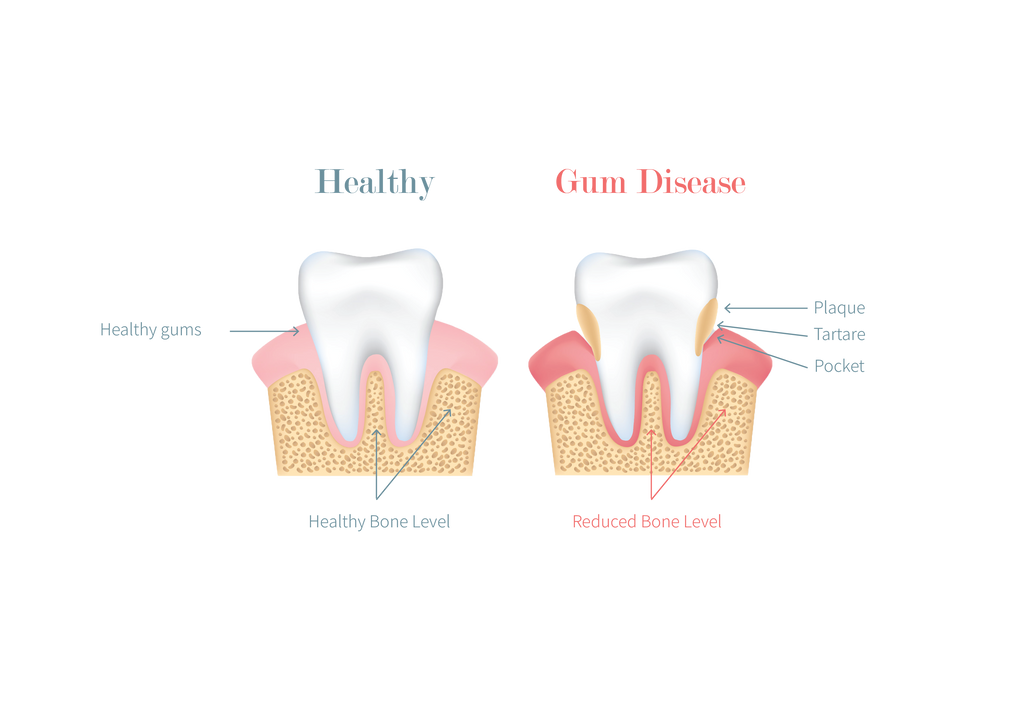
The Ultimate Guide to Maintaining Healthy Gums: Tips for a Strong Smile
Share
Are you giving your gums the attention they deserve? Your pearly whites may steal the spotlight, but healthy gums play a crucial role in maintaining overall oral health. In this blog post, we will delve into everything you need to know about gum disease – from its symptoms and stages to how you can protect and maintain those precious pink tissues. Let's dive in and give your gums some love!

What is Gum Disease?
Gum disease, also known as periodontal disease, is an inflammatory condition that affects the tissues surrounding and supporting the teeth. It is caused by the build-up of plaque – a sticky film of bacteria – on the teeth. When plaque hardens into tartar, it can lead to gum irritation and infection.
The early stage of gum disease is gingivitis, characterized by red, swollen gums that may bleed during brushing or flossing. If left untreated, gingivitis can progress to periodontitis, where the inner layer of the gum and bone pull away from the teeth forming pockets that become infected.
Advanced periodontitis can result in significant damage to the bone and tissues supporting your teeth. This can lead to tooth loss if not properly addressed. Regular dental check-ups and good oral hygiene practices are key in preventing gum disease from taking hold.
Signs and Symptoms of Unhealthy Gums
Do you often notice your gums bleeding when you brush or floss? This could be an early sign of gum disease. Along with bleeding, other symptoms to watch out for include redness, swelling, and tenderness in the gums. Bad breath that doesn't seem to go away even with proper oral hygiene could also indicate gum disease.
As the condition progresses, you may experience receding gums, causing your teeth to appear longer than usual. Loose teeth or changes in how your bite feels can signal advanced stages of gum disease. Pay attention to any pus around the teeth and gums as it signifies infection.
If left untreated, gum disease can lead to tooth loss and impact overall health. Regular dental check-ups are essential in detecting and addressing any signs of gum disease early on. Remember, prevention is key when it comes to maintaining healthy gums!

Three Stages of gum deterioration
Gum disease progresses in three stages, each with its characteristics and implications for oral health.
The first stage is gingivitis, marked by red, swollen gums that may bleed during brushing or flossing. At this point, the damage is reversible with proper care.
If left untreated, gingivitis can advance to periodontitis. In this stage, the infection spreads beneath the gum line, leading to pockets forming between teeth and gums. This can cause further inflammation and damage to the tissues supporting teeth.
Advanced periodontitis is the most severe stage of gum disease. By this point, irreversible damage has occurred to the bone and fibers holding teeth in place. Teeth may become loose or even require extraction due to extensive deterioration.
Regular dental check-ups are crucial for early detection and intervention at any stage of gum disease. Maintaining good oral hygiene practices is key in preventing progression to more severe stages of gum disease.
So, who is at risk?
Gum disease doesn't discriminate. It can affect anyone, regardless of age or background. However, certain factors can increase the risk of developing gum issues. Poor oral hygiene is a major contributor - not brushing and flossing regularly allows bacteria to build up and cause inflammation.
Smoking is another significant risk factor for gum disease. Tobacco weakens the immune system and makes it harder for the body to fight off infections in the gums. Genetics also play a role; some people are simply more predisposed to gum problems due to their family history.
Health conditions such as diabetes and hormonal changes like pregnancy can make individuals more susceptible to gum disease. Medications that reduce saliva flow or have side effects on oral health can also increase the risk. Regular dental check-ups and maintaining good oral hygiene habits are vital in preventing gum disease from taking hold.

How unhealthy gum can be treated
When it comes to treating gum disease, early intervention is key. The first step often involves a deep cleaning procedure called scaling and root planing. This process removes plaque and tartar from the teeth and beneath the gums.
In more advanced cases, surgical treatments such as flap surgery or bone and tissue grafts may be necessary to restore gum health. Antibiotics or antimicrobial mouth rinses can also help combat infection and promote healing.
Regular visits to the dentist for professional cleanings are essential in managing gum disease. Maintaining good oral hygiene practices at home, such as brushing twice a day with fluoride toothpaste and flossing daily, is crucial in preventing its recurrence.
It's important to follow your dentist's recommendations closely and attend follow-up appointments to monitor progress. By taking proactive steps towards treatment, you can protect your gums and overall oral health in the long run.

Daily Habits for Maintaining Healthy Gums
To maintain healthy gums, it is essential to establish a consistent oral care routine. This includes brushing your teeth at least twice a day with fluoride toothpaste and using an antimicrobial mouthwash to help reduce plaque buildup. Additionally, regular flossing is crucial in removing food particles and bacteria from between the teeth where toothbrushes can't reach.
Eating a balanced diet rich in fruits, vegetables, and whole grains can also contribute to gum health by providing essential nutrients like vitamin C that support gum tissue integrity. Avoiding sugary snacks and beverages can help prevent cavities and reduce the risk of gum disease.
Regular dental check-ups are key in detecting any early signs of gum problems or other oral issues before they escalate. Your dentist can provide professional cleanings to remove hardened plaque (tartar) that may be challenging to eliminate with regular brushing alone.
By incorporating these practices into your daily routine, you can take proactive steps toward maintaining healthy gums for years to come.
What is the right way to brush?
When it comes to maintaining healthy gums, proper brushing techniques play a crucial role. To ensure you are brushing your teeth effectively, start by choosing a soft-bristled toothbrush that can reach all areas of your mouth easily.
Hold the brush at a 45-degree angle towards your gum line and use gentle circular motions to clean the front and back surfaces of your teeth. Make sure to spend at least two minutes brushing, covering all areas thoroughly including the chewing surfaces.
Avoid applying too much pressure as this can damage your gums over time. Instead, focus on using gentle strokes to remove plaque and food particles effectively. Don't forget to brush your tongue as well to eliminate bacteria that can cause bad breath.
Remember to replace your toothbrush every three months or sooner if the bristles appear frayed. By following these simple steps daily, you can maintain healthy gums and improve your overall oral hygiene routine.

Proper Flossing Techniques
Once you have finished brushing your teeth, it's time to floss. Flossing is essential for removing plaque and food particles that your toothbrush might miss. To properly floss, take a piece of dental floss about 18 inches long and wrap it around your fingers. Gently guide the floss in between each tooth, making sure to curve it against the side of each tooth in a C shape to clean below the gum line.
Remember, maintaining healthy gums is crucial for overall oral health. By practicing good oral hygiene habits like proper brushing and flossing techniques, regularly visiting your dentist for check-ups, and being aware of the symptoms and risks of gum disease, you can protect your gums and smile confidently knowing that you are taking care of them properly.
